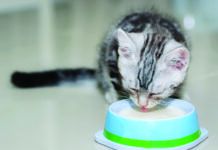Researchers at the Cummings School of Veterinary Medicine at Tufts University recently analyzed 90 canned foods from 45 brands to determine if commercial canned cat foods meet the thiamine requirements set by the Association of American Feed Control Officials (AAFCO). This study was prompted by six recalls of thiamine-deficient cat food in the past five years.
Thiamine (vitamin B1) is an essential nutrient needed for carbohydrate metabolism, muscle contraction and nerve conduction. Because very small amounts of thiamine are stored in the body, cats (and all animals) depend on a steady dietary source of this vitamin. Thiamine is found naturally in food sources such as whole grain cereals, nuts, legumes, brewer’s yeast and meat products.
According to the study — which was published in the Journal of the American Veterinary Medical Association — 12 of the 90 analyzed foods (or 13 percent) did not meet the minimum thiamine requirements set by AAFCO. Although the names of the foods were not disclosed, the research indicated that pate’-style food had lower thiamine levels than non-pate’ foods, and that food manufactured by smaller companies had lower thiamine levels than those made by large ones.
The researchers concluded that pet food manufacturers need to implement stricter quality controls to ensure adequate thiamine levels for cats. Additionally, they suggested that veterinarians consider thiamine deficiency as a possible diagnosis when presented with feline patients experiencing “acute neurologic dysfunction, especially with accompanying gastrointestinal signs.”
After two to four weeks of a thiamine deficient diet, cats can exhibit salivation, anorexia (loss of appetite) and sometimes vomiting, which can progress to neurological signs such as difficulty walking, blindness and seizures.


